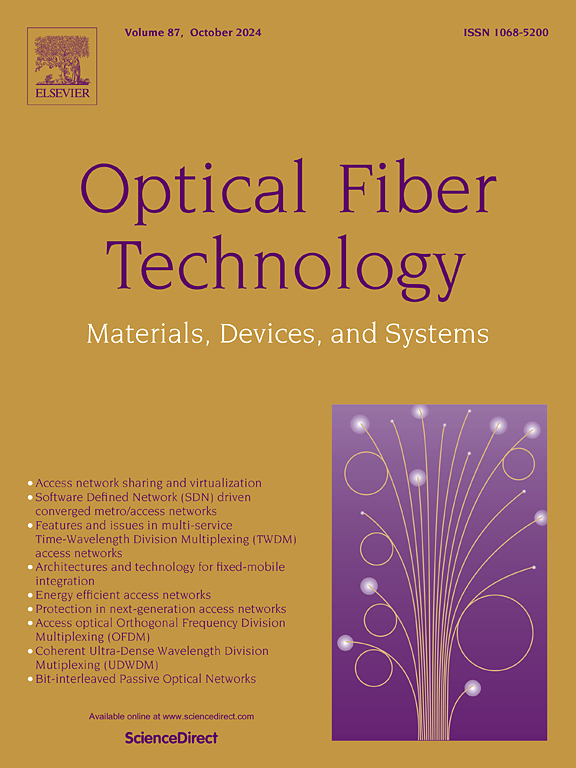All-fiber dispersion-managed erbium-doped fiber laser based on Ge2Sb2Te5 saturable absorber
IF 2.6
3区 计算机科学
Q2 ENGINEERING, ELECTRICAL & ELECTRONIC
引用次数: 0
Abstract
This experiment adopted the liquid phase exfoliation (LPE) method to prepare the Ge2Sb2Te5 (GST) nanosheet solution. By dropping the GST nanosheet solution onto the tapered optical fiber to form the saturable absorber(SA), we constructed a ring cavity system of GST-SA based on the 1.5 µm band and realized the application of GST in the field of fiber lasers. Dispersion management (DM) is achieved by adjusting the length of single-mode fibers. In the cases where the net dispersion was −0.234 ps2, −0.366 ps2, −0.476 ps2, and −0.848 ps2 respectively, stable conventional soliton (CS) mode-locked operations were obtained respectively. The maximum 3 dB bandwidth of the CS was as high as 5.67 nm. Under the net dispersion environment of −0.234 ps2 and −0.366 ps2, the harmonic mode-locked (HML) operations of the 1st to 3rd orders and up to the 6th order were obtained. This is the highest-order harmonic mode-locked currently obtained by the fiber laser based on GST-SA. The experimental results show that GST has excellent nonlinear optical modulation performance, which will creat opportunities for obtaining high-performance soliton fiber lasers.
基于Ge2Sb2Te5饱和吸收体的全光纤色散管理掺铒光纤激光器
本实验采用液相剥离(LPE)法制备Ge2Sb2Te5 (GST)纳米片溶液。通过将GST纳米片溶液滴入锥形光纤形成可饱和吸收体(SA),构建了基于1.5µm波段的GST-SA环形腔体系,实现了GST在光纤激光器领域的应用。色散管理(DM)是通过调节单模光纤的长度实现的。在净色散分别为- 0.234 ps2、- 0.366 ps2、- 0.476 ps2和- 0.848 ps2的情况下,分别获得了稳定的常规孤子(CS)锁模操作。CS的最大3db带宽高达5.67 nm。在−0.234 ps2和−0.366 ps2的净色散环境下,获得了1 ~ 3阶和最高6阶的谐波锁模运算。这是目前基于GST-SA的光纤激光器获得的最高阶谐波锁模。实验结果表明,GST具有良好的非线性光调制性能,为获得高性能孤子光纤激光器创造了机会。
本文章由计算机程序翻译,如有差异,请以英文原文为准。
求助全文
约1分钟内获得全文
求助全文
来源期刊

Optical Fiber Technology
工程技术-电信学
CiteScore
4.80
自引率
11.10%
发文量
327
审稿时长
63 days
期刊介绍:
Innovations in optical fiber technology are revolutionizing world communications. Newly developed fiber amplifiers allow for direct transmission of high-speed signals over transcontinental distances without the need for electronic regeneration. Optical fibers find new applications in data processing. The impact of fiber materials, devices, and systems on communications in the coming decades will create an abundance of primary literature and the need for up-to-date reviews.
Optical Fiber Technology: Materials, Devices, and Systems is a new cutting-edge journal designed to fill a need in this rapidly evolving field for speedy publication of regular length papers. Both theoretical and experimental papers on fiber materials, devices, and system performance evaluation and measurements are eligible, with emphasis on practical applications.
 求助内容:
求助内容: 应助结果提醒方式:
应助结果提醒方式:


